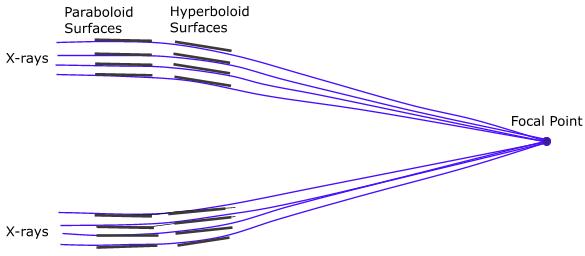 |
Goddard Space
Flight Center NASA > GSFC > Astrophysics Science Division > IXO |
|
For soft X-rays (~1 keV), the critical angle (the angle below which x-rays can be efficiently scattered from smooth surfaces) is a few degrees, but it scales approximately inversely with energy. And this is a challenge for hard X-ray optics, because as the graze angle decreases the projected area of a mirror shell becomes very small. To overcome this one must utilize a large number of mirror shells and a focal length as long as possible. A typical mirror shell configuration first proposed by Wolter, utilizes two reflections – the first from a parabolic surface and the second from a hyperbolic surface – to produce an image that is essentially coma free. See figure below.
In addition to the primary and secondary mirror sets, the Flight Mirror Assembly (FMA) will be equipped with a straylight baffle made from aluminum to block the stray X-rays, which reached the mirror focus after only a single reflection. The size of the baffle is dependent on the cone angle of the mirror shells.

A Wolter-1 mirror configuration containing 4 nested shells
Replicated nickel optics has been used extensively in X-ray astronomy in such missions as XMM-Newton, JETX/Swift and SAX. In the electroformed nickel replication (ENR) fabrication process, nickel mirror shells are electroformed onto a figured and superpolished aluminum mandrel. Later mirror shells are released from the mandrel using differential thermal contraction. This process was pioneered in Italy for x-ray mirror fabrication and has been used for soft-X-ray astronomy in such missions as XMM-Newton, which featured 3 mirror modules each with 68 electroformed nickel shells.
A distinct advantages of ENR are that the resulting mirror shells are inherently very stable and this stability, in turn, permits good figure accuracy, and hence very good angular resolution. Also, multiple identical copies can be made from a single mandrel and this allows the easy fabrication of multiple mirror modules. However, the high density of nickel necessitates very thin shells for the lightweight optics necessary to keep payload budget reasonable. The shells, however, proved to be strong enough to withstand the stresses of fabrication and subsequent handling without being permanently deformed.